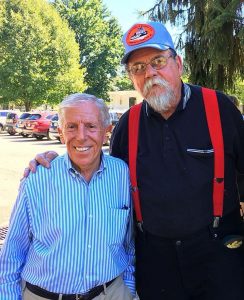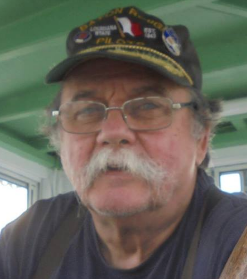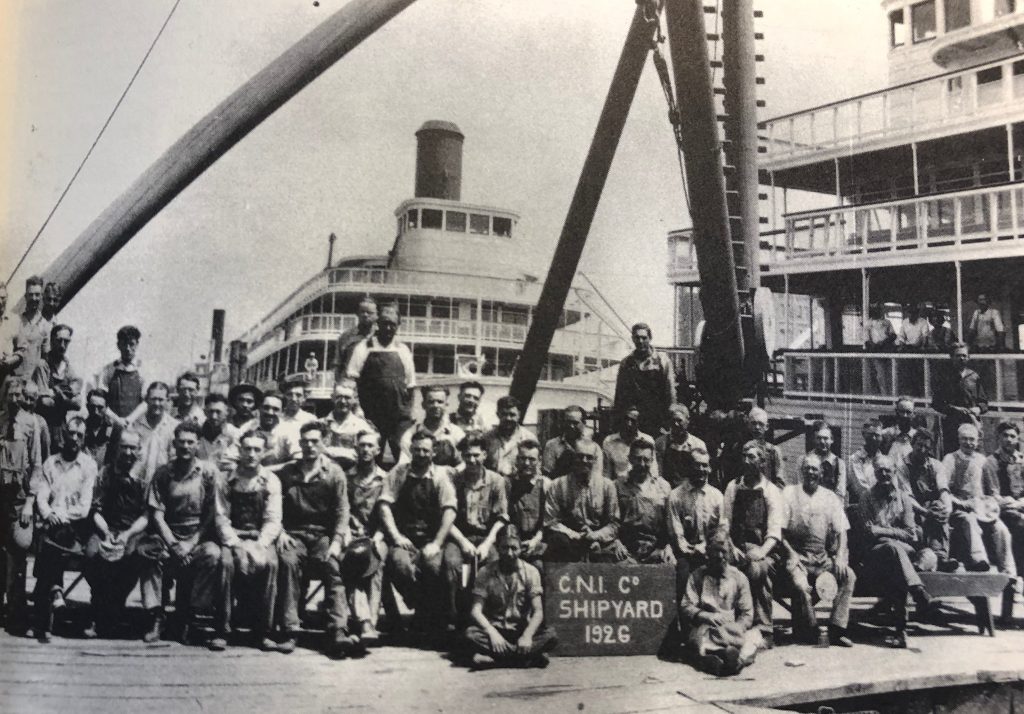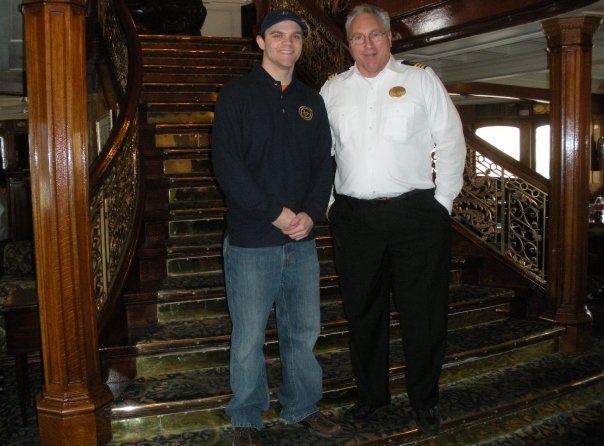The riverboat captain is a storyteller, and Captain Don Sanders will be sharing the stories of his long association with the river — from discovery to a way of love and life. This is a part of a long and continuing story.
By Captain Don Sanders
Special to NKyTribune
Although I don’t know how you’re feeling, I’m still reeling after following the news of Hurricane Ida mauling the Gulf Coast this past week. Like any true steamboat or towboat man or woman, I was on edge watching the Weather Channel until announcements from my lower river boatin’ buddies found them still afloat once Ida moved on to wreak havoc along a lengthy trek to the northeast.

I’m still reeling after following the news of Hurricane Ida mauling the Gulf Coast this past week. (Weather Channel Photo)
On the internet, often called the “electronic sternline telegraph” these days, an assortment of DELTA QUEEN zealots were questioning why the owners of the venerable steamboat, tied up in a slough somewhere near Houma, Louisiana, hadn’t “moved the boat to safety” despite part-owner and frequent DQ spokesperson Phillip Johnson’s assurances that the QUEEN was dogged down securely with multiple lines, lashings, and with her massive anchor and chain extended ashore for added commitment to the old girl’s survival.
Personally, I focused more on the well-being of the Steamer NATCHEZ and her baby-sister boat, the CITY of NEW ORLEANS (CNO) since both these vessels had to face the brunt of the Catagory 4 Hurricane moored alongside the New Orleans Steamboat Company’s wharf on the open and exposed Mississippi River.
My long-time friend and steamboat mentor, Captain Clarke C. “Doc” Hawley, joined Captain Matt Dow and the crew of the CNO where, together, they rode out the storm. Not until four days after Hurricane Ida made landfall did I telephone Captain Doc. From postings passed on by the veteran steamboater, Judy Patsch, and others, I knew that the captains and crew of the New Orleans boats survived with minimal damage. Still, I had to talk to Cap’n Hawley, personally, to get his impressions of the tempest.

The Steamer NATCHEZ and her baby-sister boat, the CITY of NEW ORLEANS had to face the brunt of the Catagory 4 Hurricane on the open and exposed Mississippi River.
“This storm was so weird,” began Captain Doc. “As you know, It’s 95 miles from the foot of Canal Street to the Gulf of Mexico, but that darned river rose seven feet in just over three hours. We had a tough time keeping the boats against the dock despite the wind blowing hard ashore. As fast as the river rose, the crew kept taking up the slack in the lines, and when the water started falling, the boys had to slack off just as fast. Imagine all that taking place with 117 mile-per-hour winds howling around.
“Ida was the worst hurricane I ever rode out as we couldn’t get to better water. But, with all the other storms, we had time to move the NATCHEZ upriver, usually to Bayou Goula Towhead, and snug ‘er up between the island and the shore outside the channel to get some relief from the wind.”
As I strained to comprehend every word from the sage steamboat master coming through my cheap, pay-as-you-go phone held closely against my ear, Captain Doc continued, “Luckily, the NATCHEZ, that had been in the Industrial Canal for renovation, was able to get one boiler fired up. But the Engine Order Telegraph (EOT), the direct line of communication between the pilothouse and the engineroom, wasn’t set up yet. So every order the Captain yelled from the Wing Bridge to the pilot had to be relayed to the engineer by the in-house telephone.
“Across the river on the Algiers side,” he resumed, “25 loaded grain barges strained against their ‘leavin’ lines’ while we feared they’d break loose at any minute and come storming across the river and plow into the side of us. But, after the storm blew on past, we discovered only minimal damage. Both boats, of course, had electricity and air-conditioning, so I spent the last three nights aboard the CITY.

My long-time friend and steamboat mentor, Captain Clarke C. “Doc” Hawley and myself, September 2018.
“Thank goodness the NATCHEZ had one boiler working.”
The closest I’ve come to experiencing a hurricane in New Orleans must have happened sometime in 1970. The DELTA QUEEN was moored at the upper end of the Governor Nicholls Street Wharf in the French Market when Captain Ernie Wagner summoned his officers and staff to announce that the boat would be delayed leaving at its usual afternoon departure time. Cap further explained that a hurricane was barreling toward New Orleans but wasn’t expected to make a direct hit. Instead, he talked about the “tail end” of the storm that was expected to cause a glancing blow with probable high winds and an abundance of rain. Fifty years ago, weather forecasting was not the sit-at-home-in-front-of-the-TV experience we see today watching the anxious antics of a Weather Channel “meteorologist” hamming it up for the camera. The Captain had no other information other than saying New Orleans would be in the “tail end of a hurricane,” and after lacing up the QUEEN with every line onboard the boat, she’d stay when she was until it was safe for him to deem otherwise.
As frightening as the thought of an approaching hurricane seemed, no order came to abandon the wooden vessel and get everyone ashore and into shelters. Consequently, I accepted the wisdom of the Captain and vowed to enjoy the oncoming blow. Down on the bow, I found shelter from the direct effects of the howling winds where I witnessed the darkened waters of the Mississippi whipped into a white, foamy lather resembling shaving cream. The roll and pitch of the heavy steamboat were barely noticeable, although the screaming wind howling through the steel rigging on the mainmast suggested Hollywood films of sailing ships caught at sea in shrieking tempests.

Across the river on the Algiers side, 25 loaded grain barges strained against their “leavin’ lines” while we feared they’d break loose at any minute and come storming across the river.
(Cody Landry Photo)
Within a couple of hours, the “tail end” of the storm blew by. As Captain Wagner announced the departure of the DELTA QUEEN within another 60 minutes, a strange character appeared dancing along the shore on the waterward side of the French Market. He, or she, was shrouded in a long white vestment covering their body except for their face and cranium. A pale, white mask with a pointed beak fitted over the dancer’s head, making the reveler look all the world like a Plague Doctor during the “sickness” of the 17th-Century. When I attempted to approach the pale merrymaker and beckon it toward where I watched from the bow of the QUEEN, the apparition turned and floated like a windborne leaf to the top of the levee and fled between the abandoned stalls of the marketplace.
Once the DELTA QUEEN was underway and steaming up the tempest-tossed waterway, clouds shrouding the Crescent City parted and allowed a bright sun to warm the chill the storm brought earlier. Mammoth waves higher than the main deck of the steamboat rolled up the Mississippi, unlike anything I’d ever seen on the river. But the QUEEN, built for the restless waters of San Francisco Bay, took the rollers in stride without unduly rocking the boat. Instead, the DELTA QUEEN plowed into each swell with its pointy ship’s bow and sliced through the waves like a sharp ax severing a sugar melon. Throughout the afternoon, until the watch ended, my crew and I savored one of the greatest rides anyone surely encountered aboard the DELTA QUEEN.

My crew and I savored one of the greatest rides anyone surely encountered aboard the DELTA QUEEN.
After Hurricane Ida finished her dirty work on the Gulf Coast and moved on to cause more death, destruction, and misery along its path towards the northeastern segment of the country, Phillip Johnson was able to share this assessment of the havoc the storm caused the DELTA QUEEN:
“The DELTA QUEEN was in the west eyewall of the storm. Unfortunately, she did sustain some damage, mainly to the roof covering materials and flashing. We’re still assessing and will have updates posted to the company’s Facebook page in the coming days. But, when compared to the surrounding buildings and homes near her, she stood up well. Her builders would be very proud. That’s one stout old boat.”
Since last week’s THE RIVER column, crewmembers, friends, and family of Captain Finley Fraser have been shocked and grieved at his sudden passing. Though I never worked with Captain Fraser, I know that he was one of the most beloved and skillful Master-Pilots on the Western Rivers. Rest in Peace, Cap’n Finley Fraser…

Captain Don Sanders is a river man. He has been a riverboat captain with the Delta Queen Steamboat Company and with Rising Star Casino. He learned to fly an airplane before he learned to drive a “machine” and became a captain in the USAF. He is an adventurer, a historian, and a storyteller. Now, he is a columnist for the NKyTribune and will share his stories of growing up in Covington and his stories of the river. Hang on for the ride — the river never looked so good.

Her builders would be very proud. That’s one stout old boat.

Though I never worked with Captain Fraser, I know that he was one of the most beloved and skillful Master-Pilots on the Western Rivers. (Photo courtesy of Phillip Johnson, seen with Capt. Fraser)

A pale, white mask with a pointed beak fitted over the dancer’s head, making the reveler look all the world like a Plague Doctor during the “sickness” of the 17th-Century.

























Thank you ,Don , for putting some of the terror we river fans have felt for our 3 ladies to rest. I should have known Doc would go to “his” Natchez to help her ride it out. I’m glad they got a boiler up & had the ‘in house’ phone.
I was praying being in the slough gave our Queen some safety. At least she didn’t have to worry about loose barges or towboats aiming for her. Praying the roof damage didn’t allow water inside too much. Thanks for reminding us by she was build to take tough weather.
Good writeup. Glad the working boats came through. I fled to MS, now in Vicksburg.
This is another great article written by Captain Don! He has a wonderful command of the English language and a way of making me feel I am watching his world unfold in real time!
Capt. Don’s articles have become part of my Sunday morning routine. Thank you for providing them for all of us.
So proud of all the men who manned the steamboats and tugboats during Hurricane Ida……I was eager to read about the experiences during the storm and I loved the story of Captain Sanders in 1970 on the Delta Queen and the Plague Doctor Spirit.
In 2006, it was my pleasure to serve with Captain Finley Fraser. He worked the square watch steering and I served as one of the two Night Watchmen from 10 p.m. to 6 a.m. We were allowed 20 minutes to make our rounds, punching the watch-clock with several keys hanging at strategic locations around the passenger vessel. That schedule allowed me to hang with Finley for several conversations from midnight to six. My guess that he wanted me to call him by his first name is because he is four years younger than I am. Finley was always joyful and friendly and outgoing. Finley brought sunshine into the dark pilot-house.
Another well-written and dramatic story (still waiting for the book). After the storm, I actually got back on Facebook, where I’d taken a break, because I knew the news about the boats would be posted there. And thank you so much for the words about Captain Finley. I was lucky enough to take Bela’s shift for a week, where the generous captain taught me night navigation before I became a Riverlorian. Watchman was my favorite job on the boat. I’ll be in touch.
Thanks, everyone for your encouraging remarks. What I would have given for the privilege of weathering Hurricane Ida with Captains Doc and Matt Dow on the CITY of NEW ORLEANS, or with Capt.Steve Nicoulin and his crew on the NATCHEZ.
Captain Howard Tate often told of being in the thickest of Hurricane Betsy, 1965, while hanging on for dear life guiding the towboat, M/V DANIEL WEBSTER through the New Orleans harbor and beyond. Cap’n Tate recalled the storm blowing so powerfully hard again the WEBSTER, the stern of the towboat was entirely underwater.
It’s great to hear from all of you. Welcome back, Steamboat Mary, to “the electronic sternline telegraph.”
Let’s practice and encourage our river community friends and crewmates to get their COVID-19 vaccines, keep our hands scrubbed, socially distance ourselves… and wear decent facial protection (masks) when appropriate. Let’s strive to meet again after the pandemic – somewhere on the river.